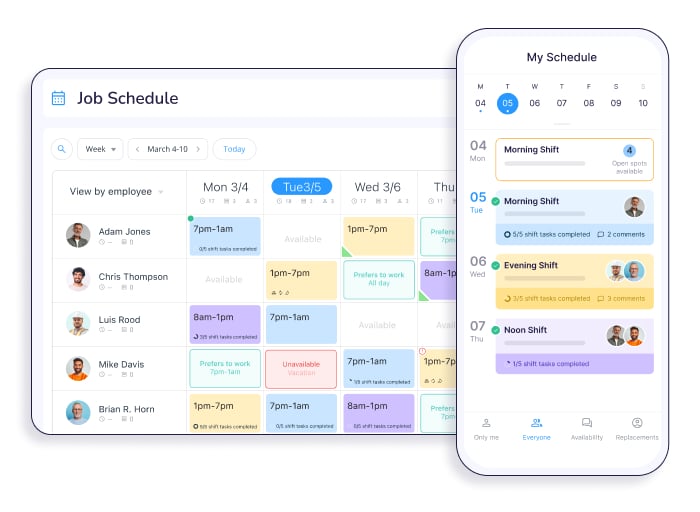Shift bidding empowers employees to bid for preferred shifts. In this guide, we discuss its pros, cons, and top tips for fair implementation.
Managing shift schedules can be a headache, especially when traditional methods lead to employee dissatisfaction and high turnover.
Shift bidding introduces a method where employees have a say in their schedules, potentially easing these issues.
In this article, we explore how shift bidding works, its benefits and challenges, and best practices for implementing it.
Key Takeaways
- Shift bidding involves employees bidding on preferred shifts based on their availability and preferences.
- Shift bidding empowers employees by allowing them to choose shifts that fit their schedules, boosting job satisfaction and engagement. However, managing it can be complex and requires careful implementation to ensure fairness.
- Effective shift bidding systems use clear criteria, technology for seamless management, and regular feedback from employees and customers to maintain fairness and efficiency.
- Connecteam supports efficient shift bidding with features like open shift creation, employee bidding, and managerial approval—ensuring fair and transparent shift allocation.
What Is Shift Bidding?
Shift bidding is a shift scheduling system where employees can express interest in the shifts they prefer to work, giving them control over their work schedules. It aims to create a fair environment while enabling managers to maintain control over shift allocation based on set criteria.
Unlike traditional employee scheduling, where managers assign shifts based primarily on operational needs, shift bidding actively empowers workers to choose their shifts. This offers them greater control over their schedules.
This method is commonly used in industries and settings with variable work hours, such as healthcare, retail, call centers, and customer service.
Shift bid meaning: What is a shift bid?
To express interest in a shift, an employee submits a shift bid, meaning they file a formal request for their preferred shifts during the shift bid process.
Difference between shift bidding, shift swapping, and self-scheduling
Shift bidding is distinct from other forms of flexible scheduling, including self-scheduling and shift swapping.
- Shift bidding: Employees compete for preferred open shifts by submitting bids.
- Self-scheduling: Employees choose their own shifts or claim open shifts based on available slots, typically within certain guidelines set by management.
- Shift swapping: Employees exchange shifts among themselves after the initial schedule is made.
How Shift Bidding Works
Shift bid process involves several key steps to ensure fairness and efficiency. Here’s how it typically unfolds:
- Managers outline available shifts for a specific period, detailing the number of positions, hours, and any special requirements for each shift.
- Employees receive notifications about the upcoming bidding period, usually through an internal system or email. These notifications tell them when and how they can submit shift bids.
- Employees submit bids into a designated system. With some systems, they can communicate their shift preferences based on their personal needs and priorities. For example, suppose an employee, Sarah, prefers to work early morning shifts but is also available for afternoon shifts. She can indicate that the early morning shifts are her top priority and the afternoon shifts are her second choice.
- Managers review employees’ bids and assign shifts, often considering factors like seniority, past performance, or other criteria to allocate shifts fairly.
- Employees are notified of their schedules.
- Workers may submit appeals to adjustments if they have valid reasons (e.g., childcare issues). Management may make adjustments based on these appeals to accommodate employees’ needs.
- Staff may exchange shifts—often with approval from management.
Many organizations employ specialized scheduling software that automates some or much of the process, ensuring transparency and reducing the administrative burden. These tools often include features for qualifying employees to shifts, resolving scheduling conflicts, tracking preferences, and more—which help streamline the entire shift bid process.

6 Benefits of Shift Bidding
Shift bidding offers significant advantages for both employees and employers, making it a popular choice in various industries. Here are some key benefits.
For employees
- Employees have the opportunity to choose shifts that best fit their personal commitments and lifestyle needs, leading to a better work-life balance.
- Having a say in one’s schedule can lead to higher job satisfaction, as employees feel more respected and valued.
- By selecting shifts that suit their energy levels and personal lives, employees can manage stress better, potentially reducing burnout.
For employers
- When employees are happier and less stressed, they’re more likely to stay with a company, reducing turnover rates.
- Employees are likely to be more productive and engaged when they work shifts they’ve chosen themselves.
- Shift bidding helps ensure shifts are covered by employees most willing to work at those times, which can lead to better performance and customer service.
One manager wrote this about shift bidding: “We typically tried to give people the shifts they wanted. If multiple people wanted the same slot we usually went by a combination of performance and seniority to decide who got it. In instances where we had a slot that needed filling we’d usually ask for volunteers first. If no one stepped up we picked someone by usually going on the opposite end of the performance/seniority spectrum.”
Challenges of Shift Bidding
While shift bidding offers many advantages, it also comes with some challenges you must manage effectively. Here are some key issues and considerations:
- Shift bidding can easily lead to favoritism, where certain employees consistently get their preferred shifts due to managerial bias or seniority. This can create resentment and a toxic work environment.
- The need to constantly bid for shifts creates uncertainty in employees’ schedules, making it difficult to plan personal and family activities. This unpredictability can create stress and affect work performance.
One employee wrote, “I hate shift bids… Ours are based upon seniority and metrics and I’m pretty good at my job so I usually get my top choice but it makes planning appointments, vacations and special occasions nearly impossible unless they fall within your current shift.”
- Employee disputes over shift assignments may arise, especially if there are popular shifts many employees want.
- Newer or less favored employees often end up with undesirable shifts, which can feel unfair and lead to higher turnover rates.
Another employee wrote, “I’m on the real time team and we still shift bid. it’s based on seniority and it’s awful. the fact that my schedule just changes every 6mo at someone else’s whim drives me crazy.”
- Employers might manipulate the bidding system to fill less desirable shifts without offering additional compensation, exploiting employees’ need for work.
- Constantly changing shifts can prevent employees from developing strong working relationships if they rarely work with the same colleagues.
- Managing the shift bidding process can be time-consuming and complex, requiring significant administrative effort to ensure fairness and efficiency. The process often involves reviewing shift bids, reviewing appeals, and making adjustments.
8 Best Practices for Implementing Shift Bidding
Implementing shift bidding effectively requires thoughtful strategies to address the inherent challenges and ensure a fair, transparent, and efficient process. Here are some best practices to consider.
Establish clear criteria for shift assignment
To help reduce favoritism and bias, define and communicate the criteria for assigning shifts, such as:
- Seniority: Prioritize employees based on their length of service.
- Performance ratings: Prioritize employees with better evaluations.
- Skill level and qualifications: Require specific competencies for specialized shifts.
- Last shift worked: Consider the recency of employees’ last shifts to prevent favoritism.
- Employee preferences: Account for specific day or shift length preferences.
Additionally, you can assign different weights to these criteria based on their importance to your operations. For instance, if 2 employees with identical seniority levels bid on the same shift, prioritize based on the next most relevant criterion, such as performance ratings.
Here’s how someone described their shift bid system: “Our shift bids are based on 3 items: Tenure is 34%, performance is 33%, and disciplinary is 33%. It rewards the length of time you’ve been with the company, good performance, and staying off of write ups or warnings.”
Other options
In addition to or instead of using criteria like the ones mentioned above, consider using a more flexible approach to assigning shifts. Here are 2 examples:
- Rotation system: Use a system of turns to ensure every employee gets some of the shifts they bid on. This is particularly useful in environments where shifts are highly desirable or particularly strenuous.
- First-come, first-served: This method can be applied in situations where the urgency of filling a shift outweighs other considerations, or when all employees have similar qualifications and there’s a tie.
Post open shifts in advance—and respond to shift bids quickly
To allow sufficient time for both planning and participation, post open shifts for bidding well in advance. For most industries, listing shifts 1 to 2 weeks ahead is advisable, but for sectors with complex scheduling needs (like healthcare), consider extending this to up to a month.
Also, don’t keep employees hanging for long. Set and follow a specific deadline for reviewing and responding to all shift bids, and make sure your employees are aware of this deadline so they can submit their bids in time to be considered.
A standard practice is to respond to shift bids within 48 to 72 hours. This ensures that employees can plan their schedules effectively and reduces the anxiety that comes with waiting for shift confirmations.
Provide documentation, training, and support
Ensuring everyone understands the system can reduce frustration and errors. Provide thorough documentation and training for all employees on:
- How the shift bidding system works.
- How to submit bids and view their status.
- Which software they’ll need to use—and how.
- The rules and guidelines related to shift bidding, including bid deadlines, how to withdraw or change a bid, and what happens in cases of conflicts or issues.
- The criteria you’ll use to evaluate bids.
- The operational requirements of different shifts, such as peak times, specific roles needed during certain hours, and any skills or certifications required for particular shifts.
Pro Tip
Use a company knowledge base like Connecteam’s to store your shift bidding policy containing your company’s shift bidding guidelines, criteria, and more.
Implement a fair appeal process
Create a formal process for employees to appeal their assigned shifts if they have legitimate concerns or conflicts. Ensure this process is accessible and transparent.
For example, you can allow workers to submit written appeals if they have valid reasons, such as family commitments or health issues. A committee or designated employee can review these appeals and make adjustments as needed.
Pro Tip
Maintain detailed records of all appeals and outcomes to refine the process over time. Regularly review the appeal process to identify and address any recurring issues.
Ensure your process is compliant
Ensure that the shift bidding system complies with all relevant laws, such as the Fair Labor Standards Act (FLSA), the Equal Employment Opportunity Act (EEOC) and related anti-discrimination laws, the Family and Medical Leave Act (FMLA), and specific state labor laws. This includes regulations regarding working hours, rest periods, overtime, predictive scheduling, and equal opportunity.
Pro Tip
Speak to a labor lawyer to determine whether your shift bid process complies with all relevant laws.
Regularly monitor
Regularly assess the effectiveness of the shift bidding system and seek feedback from employees. This can help identify any issues or areas for improvement and keep the system aligned with both employee needs and business objectives.
- Monitor signs of burnout, especially if certain employees consistently end up with less desirable shifts.
- Check for any patterns that might suggest bias in shift assignments, such as certain employees or groups always receiving preferred shifts.
- Ensure that all employees have equal access to information about the shift bidding process to prevent misinformation or misunderstandings.
- Evaluate whether all employees are comfortable using the bidding technology, as a lack of tech skills shouldn’t disadvantage anyone in the shift bid process.
- Regularly gather customer feedback to check their satisfaction. This feedback can show if certain shifts are underperforming, possibly due to how they’re staffed.
- Gather employee feedback: Conduct quarterly surveys using a survey app like Connecteam to assess employee satisfaction with the shift bid process. Use the insights gained to make necessary adjustments, ensuring the system remains fair and efficient.
Communicate regularly

Maintain open and ongoing communication with employees about the shift bidding process. This includes updates about scheduling or changes to the system, plus and responses to any employee concerns. For instance, you can use a team chat app to hold group discussions or have 1:1 conversations with your staff.
Offer incentives for less desirable shifts
Provide incentives, such as additional pay, benefits, or digital rewards for employees who bid on and work less desirable shifts. This encourages a more balanced shift distribution.
For example, a restaurant might offer a bonus for employees who work late-night or weekend shifts, making these times more attractive and ensuring adequate coverage.

Invest in a powerful tech stack
Setting up a successful shift bidding system requires using the right tools to streamline the process and ensure fairness. Here are some essential tools:
- An advanced scheduling platform that supports shift bidding.
- Communication tools for touching base about shift changes, bidding outcomes, and more.
- A mobile app that enables employees to view, bid on, and manage their shifts directly from their smartphones.
- Analytics tools that can analyze shift patterns, employee performance, and other metrics to continually refine the scheduling process.
Or—invest in an all-in-one workforce management tool like Connecteam
Connecteam is an employee scheduling software that offers a comprehensive shift bidding solution. Here’s how it works:
- You or other managers can create open shifts and specify the requirements for each shift, such as necessary skills or qualifications.
- Employees can request open shifts. Only employees who meet your requirements for each shift may submit a request.
- You or your designated schedulers can decide who gets each shift using your pre-set criteria. Connecteam gives you tons of information and various ways to view it to help you make your choice.
For instance, you can sort requests by employees’ names, the order in which they requested the shift, and the numbers of shifts each employee is scheduled to work or has claimed for the week.
When you click on individual requests, you can see information about each user, including the number of shifts they’re working or have claimed for the day or week. Depending on the limitations you’ve set, you can also see things like whether an employee will go into overtime if you approve their request. You can also view their preferred working times and weekly schedules.
You can access even more information to make your decision using Connecteam’s employee timeline management feature. This feature enables you to view your employees’ seniority levels, performance evaluations, and more.
- Your employees will be notified via email or directly through the Connecteam mobile app once you’ve approved or denied their request. You can also contact them through the Connecteam team chat app.
Connecteam also offers plenty of other features, including detailed analytics—making it a great tech stack for your shift bidding needs.
| When to Use Shift Bidding | When Not to Use Shift Bidding |
| – High employee flexibility: When employees value flexibility and have varied availability. – Diverse shifts: When there are numerous shifts to cover, including less desirable ones. – Large workforce: When manual scheduling is impractical due to the number of employees. – Fair distribution: When you’re aiming to give employees an equal opportunity to choose their preferred shifts. – Unionized environments: When union agreements include provisions for shift bidding. | – Fixed schedules: When the nature of the work requires fixed schedules for operational stability. – Critical consistency: When consistent staffing is critical for operational efficiency (e.g., highly specialized roles). – Small teams: When direct scheduling by management is more efficient. – High turnover: When shift bidding can be chaotic and inefficient. – Predictive scheduling laws: When jurisdictions with strict predictive scheduling laws limit shift flexibility. |
Set Your Shift Bidding Up for Success With the Right Tools
Shift bidding offers flexibility, but it also brings challenges like favoritism and instability. Recognizing these issues can help you implement fair practices that keep your team happy and productive.
Whether you use shift bidding or not, you should always invest in a good scheduling tool like Connecteam. Its scheduling features can help you manage shift bidding effectively. Plus, it has tons of other features to help you manage your workforce.


